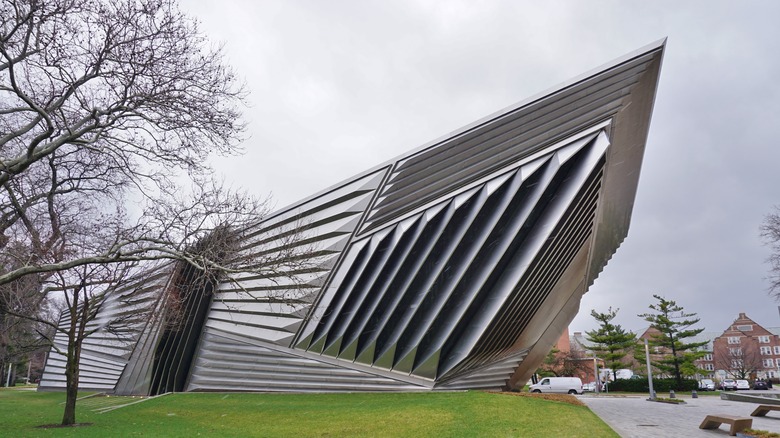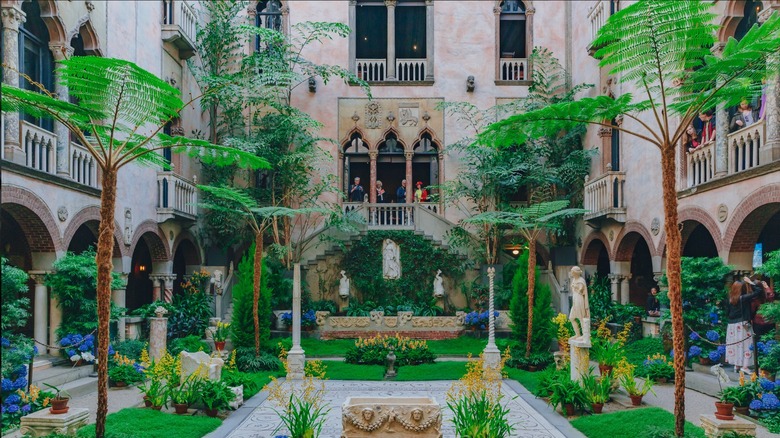5 American Museums Where The Architecture Rivals The Art
Have you ever wandered through a museum and found yourself more captivated by the architecture than the art? We can't blame you. Many museums across America are more than just buildings; they're masterpieces.
Museums are where art and architecture intersect. After all, designing a museum is about more than building four walls and a room. This is because the museum experience doesn't begin when you observe the first work of art; it begins as soon as you approach the building and walk through those doors. And when a museum has impressive architecture, it only enhances the exhibits. Think grand spaces and vaulted ceilings that make sculptures pop or walls that blend seamlessly with the collections they house.
There are many incredible destinations for art lovers in America. However, if you also want to be wowed by architecture, there are some must-see museums that combine stunning exhibits with breathtaking buildings. We've highlighted a handful of American art museums that stand out from the rest. At these locations, you'll be impressed by the artistry before stepping foot in the museum itself. Imagine surreal landscapes, stunning courtyards, and impressive facades. So if you're planning a trip to any of these destinations, set aside extra time to view these museums — both inside and out.
The Eli and Edythe Broad Art Museum at Michigan State University in East Lansing, Michigan
If you happen upon the Eli and Edythe Broad Art Museum, you might mistake it for an artsy spaceship. But this futuristic design isn't an alien shuttle that landed at Michigan State University in East Lansing, Michigan. It's the work of renowned architect Zaha Hadid.
The museum opened its doors in 2012 and focuses on contemporary art. It has over 10,000 permanent pieces along with temporary exhibits. However, the museum's architecture is one exhibit that's here to stay and holds special meaning on campus. Hadid designed this building with the students in mind. She envisioned the lines as a continuation of local pathways, representing the students' movements between the city and the campus.
The first thing you notice about the museum is its unusual exterior, with pleated stainless steel jutting out unexpectedly. The whole thing resembles a metallic carpet woven together in a bold pattern. What also makes these steel beams special is that they reflect light, offering a different perspective depending on the time of day and season. Once you enter the museum, you're in for a surprise since the interior is equally dramatic and features slanted walls and surprising angles.
The Salvador Dalí Museum in St. Petersburg, Florida
Artist Salvador Dalí's works are reminiscent of a dystopian dream, and when you approach the Salvador Dalí Museum, you will find that it evokes this same feeling. The museum originally opened in St. Petersburg, Florida in 1982. However, the new building, designed by architect Yann Weymouth, opened in 2011 and became the talk of architects worldwide. Not only is this building impressive, it also houses the largest collection of Dalí's work outside of his native Spain.
You can tell Weymouth was inspired by Dalí since surrealistic elements are prominent throughout the property. The building's glass entryway, aka the "Enigma," is impossible to miss and looks like geodesic glass bubbling down the exterior. This feature isn't just for shock value either; it allows natural light into the gallery. And as you visit each floor, you'll notice the bright space brings the artwork alive. While you're exploring, make sure to ascend the helical staircase, a reminder of Dalí's love of spiraled structures.
There's a certain fluidity to the museum, eccentricities and all. Yes, you're surrounded by over 2,400 pieces of artwork – but it's more than that. It's as if you stepped into a Dalí painting yourself, which we're guessing is the point. You won't know where the architecture ends and the art begins. But if there's one thing for certain, this museum is a must-visit for Dalí fans and architecture buffs alike.
The Isabella Stewart Gardner Museum in Boston, Massachusetts
Do you want to feel like you're in Europe without leaving America? Well, visiting the Isabella Stewart Gardner Museum offers this experience. It feels as if you're stepping into a Venetian palace complete with gardens and European art.
The Isabella Stewart Gardner Museum is located in Boston, Massachusetts –considered one of the best cities for tourism in America. The museum opened in 1903 and has maintained its fairytale charm ever since. As you set foot on the property, you get an immediate sense of beauty and grandeur, which is likely what Isabella Stewart Gardner was aiming for. This American heiress wasn't solely an art collector — she had an incredible eye for architecture as well. She took a very hands-on approach to creating this museum, from its ideation to its construction. She and her husband even traveled through Italy, purchasing columns and doorways to decorate the museum.
One of the main features of the property is a sunny courtyard bursting with greenery. It's encompassed by a four-story building with balconies and windows overlooking this central square. Adjacent to the original building is a new wing, built by architect Renzo Piano and opened in 2012. When you visit both buildings, you'll notice the museum gracefully blends old and new. You'll want to take your sweet time exploring the grounds as there's so much to see both inside and out. Take a leisurely stroll through the palace's galleries as you enjoy classic art. When you're ready to move into the modern age, visit the new building, which boasts floor-to-ceiling windows and a Michelangelo-inspired staircase.
The Crystal Bridges Museum of American Art in Bentonville, Arkansas
How do you build a museum in the Ozarks without detracting from nature? You blend it with the surrounding landscape. This is precisely what architect Moshe Safdie did when designing the Crystal Bridges Museum of American Art in Bentonville, Arkansas.
Safdie built a series of interconnected pavilions that weave their way around ponds and are connected by bridges. The curvature of the buildings blends into the mountain backdrop. Meanwhile, the use of copper and local timber gives the structure a natural feel.
The floor-to-ceiling windows also enhance the architectural experience. They allow the light to shine into the galleries, where you'll find works by a host of American artists from various periods. And if you take a glimpse outside, you'll witness the gorgeous forests and water that encompass the property. Overall, this museum is a triple threat of art, architecture, and nature. It just goes to show that stunning architecture isn't solely reserved for cities. So if you love both the great outdoors and museums, this Arkansas destination is a must-see, especially when visiting the Ozarks in autumn.
The Milwaukee Art Museum in Milwaukee, Wisconsin
You can't envision the skyline of Milwaukee, Wisconsin without the iconic Milwaukee Art Museum. The building was designed by three architects: Eero Saarinen, David Kahler, and Santiago Calatrava. However, the most famous portion is Calatrava's addition, the Quadracci Pavilion.
From above, the Quadracci Pavilion looks like a giant white bird opening its wings — perhaps in preparation for flight. These wings, formally called the Burke Brise Soleil, are actually movable sunscreens that open and close twice daily. The sunscreens open when the museum does and fold shut as the museum closes. It's unlikely you'll visit for this entire duration, but if you come at noon, you'll witness these wings fold and unfold purely for show.
The building also boasts a breathtaking interior, which includes pristine white walls curving upwards towards a 90-foot-high glass ceiling. These walls feature all kinds of artwork from centuries-old European paintings to modern photography. But with so much to see inside and out, it's likely art aficionados will build up quite the appetite. After exploring this museum, you may want to enjoy another iconic Milwaukee destination: the Lakeside Brewery. It's known as one of America's best breweries and is just a 10-minute drive from the museum.





